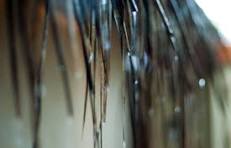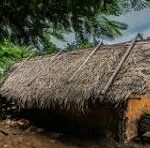Do thatched roofs leak? Debunking the Myth of Leakage Once and for All

Welcome to our exploration of an age-old question: Do thatched roofs leak? Thatched roofs have long captivated admirers with their rustic charm and timeless appeal. However, thatched roofs can indeed leak if not properly constructed, maintained, or if subjected to extreme weather conditions.
When constructed well with high-quality materials and meticulous craftsmanship, thatched roofs can indeed be remarkably durable, standing the test of time and providing reliable protection against the elements.
Contrary to popular belief, thatched roofs boast a range of advantages that make them more than just a picturesque addition to any landscape. Their natural insulating properties not only regulate indoor temperatures but also provide a cozy atmosphere during winter months. Additionally, the flexibility of thatching materials allows for intricate designs and customization, enhancing the aesthetic appeal of any property. By understanding the unique advantages of thatched roofs, homeowners can appreciate their beauty while enjoying peace of mind about their durability.
Common Concerns: The Question of Leakage
One of the foremost concerns among those considering thatched roofs is the issue of leakage. While these roofs exude an undeniable charm, some may wonder if they are practical in terms of keeping the elements at bay. In this article, we delve into the intricacies of thatched roof construction and maintenance to explore whether leakage is indeed a common occurrence.
Understanding Thatched Roofs
Exploring the Anatomy of a Thatched Roof
At first glance, a thatched roof may appear as a simple covering of straw or reeds. However, a closer inspection reveals a sophisticated layering system designed to provide both insulation and protection against the elements. Understanding the anatomy of a thatched roof is crucial to grasping how it withstands potential leakage.
Layers of Protection: Anatomy of a Thatched Roof
Thatched roofs typically consist of several layers, each serving a specific purpose in fortifying the structure against leakage. From the sturdy wooden framework to the intricate weaving of thatching material, every component plays a vital role in maintaining the roof’s integrity.
Materials Used in Thatched Roofs: From Straw to Reeds
The choice of materials greatly influences the durability and resilience of a thatched roof. While straw and reeds are among the most common options, variations exist based on regional availability and climate considerations. Understanding the characteristics of each material is essential in assessing their potential for leakage.
A Brief History of Thatched Roofs
Origins and Cultural Significance
Thatched roofs trace their origins back to ancient civilizations, where they were valued for their abundance and simplicity. Across cultures, thatched roofs held symbolic significance, often representing a connection to nature and the land.
Evolution and Adaptation Over Time
Over the centuries, thatched roof construction techniques have evolved in response to changing architectural styles and technological advancements. Despite these adaptations, the fundamental principles of thatched roof construction have remained remarkably consistent, highlighting their enduring appeal.
Factors Influencing Leakage
Climate Considerations
The climate in which a thatched roof is situated plays a significant role in its susceptibility to leakage. From heavy rainfall to extreme temperatures, various weather patterns can impact the roof’s ability to repel moisture effectively.
Impact of Weather Patterns on Thatched Roofs
Regions characterized by frequent rainfall or high humidity levels may experience increased instances of thatched roof leakage. Conversely, arid climates pose their own challenges, as prolonged exposure to intense sunlight can cause thatching materials to dry out and become brittle.
Regions Prone to Thatched Roof Leakage
Certain geographical areas may be more prone to thatched roofs leak due to environmental factors such as proximity to coastal regions or prevailing wind patterns. Understanding these regional nuances is essential for homeowners considering the installation of a thatched roof.
Roof Pitch and Design
The Role of Roof Pitch in Water Shedding
The pitch or slope of a thatched roof plays a crucial role in facilitating water runoff and preventing pooling, thereby minimizing the risk of leakage. Properly designed roofs feature a pitch optimized for efficient water shedding.
Design Features to Minimize Leakage
In addition to roof pitch, incorporating specific design features can further enhance a thatched roof’s ability to withstand leakage. From strategically placed ridge caps to proper eave overhangs, these design elements are instrumental in safeguarding the integrity of the roof.
Common Causes of Leakage
Wear and Tear Over Time
As with any roofing material, thatched roofs are susceptible to natural wear and tear over time. Exposure to the elements, fluctuations in temperature, and physical damage can all contribute to the gradual degradation of thatching materials, potentially leading to leakage.
Understanding the Natural Degradation of Thatched Roofs
Thatching materials undergo a natural aging process characterized by shrinkage, decomposition, and loss of elasticity. Over time, these changes can compromise the tightness of the thatched layer, creating vulnerabilities that may result in leakage.
Signs of Wear: Identifying Potential Leakage Points
Homeowners should be vigilant and watch out for thatched roof leaks and for signs of wear and deterioration. From sagging roof sections to visible gaps in the thatching material, identifying these warning signs early on can help prevent minor issues from escalating into major leaks.
The Threat of Pests and Rodents to Thatched Roofs
Pests and rodents pose a significant threat to the integrity of thatched roofs, as they can burrow into the thatching material and cause the roofs to to leak when there is a downpour. Additionally, nesting birds may peck at the thatch, further weakening its protective barrier.
Strategies for Pest Prevention and Control
Implementing proactive measures to deter pests and rodents is essential for maintaining the integrity of a thatched roof. From installing bird deterrents to sealing potential entry points, homeowners can mitigate the risk of pest-related damage and subsequent leakage.
Importance of Proper Installation Techniques
The longevity and performance of a thatched roof hinge upon the quality of its initial installation. Skilled craftsmen utilize specialized techniques to ensure proper thatch layering, secure attachment to the roof structure, and effective water shedding capabilities.
Regular Maintenance Routines to Prevent thatched roof Leaks
Ongoing maintenance is critical for preserving the integrity of a thatched roof and minimizing the risk of leakage. Routine inspections, timely repairs, and proactive measures such as moss removal and debris clearance are essential components of a comprehensive maintenance strategy.
Preventing and Addressing Leakage
Taking a proactive approach to roof maintenance is key to preventing leakage and prolonging the lifespan of a thatched roof. By identifying and addressing potential issues before they escalate, homeowners can mitigate the risk of water damage and structural deterioration.
Regular inspections should be conducted to assess the condition of the thatched roof and identify any areas of concern. During these inspections, attention should be paid to the integrity of the thatching material, the condition of the roof structure, and the presence of any signs of leakage.
Promptly addressing minor issues such as loose thatch or damaged ridge caps can prevent them from worsening and potentially causing leakage. Homeowners should have a plan in place for addressing these issues as soon as they are identified.
Strategies for preventing thatched roofs leak
Waterproofing Techniques for Thatched Roofs
Applying waterproofing treatments to a thatched roof can enhance its ability to repel moisture and reduce the risk of leakage. Various products are available, ranging from traditional lime washes to modern sealants specifically formulated for thatching materials.
Implementing Protective Measures During Construction
During the initial construction phase, certain measures can be taken to minimize the risk of leakage in a thatched roof. These may include incorporating additional layers of thatching material in vulnerable areas, installing proper flashing and waterproof membranes, and ensuring adequate roof ventilation.
Repairing Leaks
When a leak occurs, identifying the source is the first step in initiating repairs. Thatched roofs can develop leaks for various reasons, including damaged thatching material, compromised roof structure, or inadequate waterproofing.
Certain areas of a thatched roof are more susceptible to leakage than others. These include roof valleys, ridges, eaves, and areas around chimneys or skylights. Thoroughly inspecting these vulnerable areas can help pinpoint the source of a leak.
To effectively repair a leak, a thorough inspection of the roof must be conducted to assess the extent of the damage and identify any underlying issues. This may involve removing sections of thatching material to expose the roof structure and assess its condition.
DIY Repair Tips
In some cases, homeowners may be able to temporarily patch minor leaks themselves until professional repairs can be arranged. Temporary fixes may include applying roofing cement or sealant to the affected area or using waterproof tape as a temporary barrier.
For those comfortable with DIY repairs, having the right tools and materials on hand is essential. Common tools may include a ladder, hammer, nails, roofing cement, sealant, and replacement thatching material. Additionally, safety equipment such as gloves and eye protection should be worn when working at heights.
Hiring Professional Thatchers
For more extensive or complex leaks, or for homeowners who are not comfortable performing repairs themselves, hiring a professional thatcher is recommended. Professional thatchers have the knowledge, skills, and specialized tools needed to address leaks effectively and ensure the long-term integrity of the roof.
When seeking out a professional thatcher for repairs, homeowners should look for individuals or companies with a proven track record of expertise in thatched roof construction and maintenance. Recommendations from local contacts, online reviews, and professional associations can help identify reputable thatchers in the area.
Dispelling Common Myths About Thatched Roofs
Despite their enduring popularity, thatched roofs are often subject to misconceptions and myths. By addressing these myths head-on, homeowners can make informed decisions about the suitability of thatched roofs for their properties.
One of the most pervasive myths about thatched roofs is that they are inherently prone to leakage. While it is true that thatched roofs require proper maintenance to prevent leakage, with regular upkeep and proactive measures, leaks can be minimized and managed effectively.
Another common misconception is that thatched roofs are not as durable or long-lasting as other roofing materials. In reality, when properly constructed and maintained, thatched roofs can provide decades of reliable performance and timeless beauty.
Conclusion
Despite the concerns surrounding leakage, the allure of thatched roofs remains undiminished. Their unique aesthetic appeal, cultural significance, and environmental sustainability continue to captivate homeowners around the world.
By gaining a deeper understanding of the factors influencing leakage in thatched roofs and implementing proactive maintenance strategies, homeowners can enjoy the beauty and benefits of thatched roofs for years to come. With proper care and attention, they can provide a durable and enchanting covering that stops thatched roofs leak.









